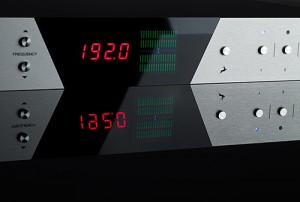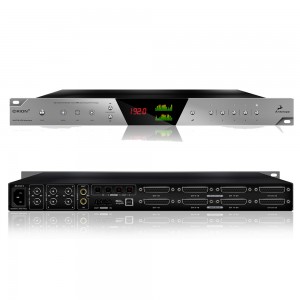Review: Antelope Orion 32, A Mixer's Perspective
I started this review with a healthy amount of skepticism. Having owned a Lynx Aurora 16 AD/DA converter for many years, I couldn’t believe that the Antelope Orion 32 – a single rack unit device with twice the analog channels for the same price – could compete in terms of sound quality. But Antelope is a very reputable company known for making high quality (and high-priced) equipment so it also seemed unlikely they would suddenly make a crap device. I needed to hear this thing!
AARDVARK BEGINS WITH A
Antelope Audio started out as a clocking company, an outgrowth of Igor Levin’s Aardvark company, famous for making one of the earliest popular external clocks, the Aardsync. I still have one in my closet, it only goes to 48kHz, but it definitely made my old Digi003 sound better.
Today the company makes some crazy high-end gear. They came out in 2005 with the Isochrone line, employing their proprietary “oven” system, which keeps the crystal oscillator in a small enclosure in order to keep the temperature constant, thereby keeping the crystal beating more consistently. Their current top of the line clock, the 10M currently sells for $6,000! That’s just a clock! There’s a lot of debate about whether external clocks are a good idea, but my personal experience has been that they can help. I wouldn’t spend $6K on a clock, but there are people who do, and Antelope markets towards those people by making no-compromise gear. On that tip, Antelope is also big in the audiophile market – hi-fi enthusiast buyers who tend towards extreme build quality.
Alongside the clocks, Antelope also makes converters – again mostly on the highest-end price and spec-wise – some for the audiophile market and some for us pro audio engineers. In 2011, they introduced the Eclipse 2-channel AD/DA converter and this year they released the Orion, a 32-channel AD/DA converter in a single rack space, and the subject of this review.
THE BELT OF ORION
As I said, when I first heard about it, I was skeptical. Looking at the specs it seemed improbable that it could be a quality machine: 32 channels of analog in and out via D-SUB connectors, working up to 192kHz, all over USB2. It also has 64 channels of MADI, 16 channels of ADAT, and 2 channels of S/PDIF. Seemed unlikely that all this, fit into one rack space, would be possible at the $2,995 price point. They had to cut corners somewhere, right?
As soon as I started unpacking it, however, things were already looking good. The Orion is packed like an Apple product: a full color outer sleeve slides off to reveal a black plastic coated box that opens in the middle to reveal your juicy product. Ooooo, fancy! They really did a good job with the packaging – something other companies don’t seem to give much thought.
The unit itself is pretty awesome looking – great machining on the metal enclosure, nice buttons, an interesting asymmetrical rack mounting system, and a crazy good display. The display shows all 32 channels of input and outputs at the same time with three color bar graphs. Pretty cool stuff. Build quality seems immediately very good, no rattling or flexing on the unit. It’s also pretty light-weight, though not so much that it feels cheap.
According to the specs, the Orion should transmit 32 channels of 96kHz audio and 24 channels of 192kHz on the Mac via USB2; on PC, it’ll do 32 channels at both 96kHz and 192KHz.
IN USE
My work is primarily mixing, mostly albums but also movies, TV shows and commercials as well. Like most working professionals, time is very important to my service quality and, consequently, my tools must function perfectly as much as possible. My current setup includes a Lynx Aurora 16 channel fed into a Roll Music Folcrom summing mixer, returned into a Universal Audio Apollo and monitored using a Dangerous Music D-Box.
If I’m mixing an album I usually use the Aurora into the Folcrom returning into the Apollo mic pres or Sytek MPA-4ii Burr Brown units. If I’m working on a commercial or post work I usually just use the Apollo. Occasionally I work on a record with a smaller track count and use the D-Box summing mixer. One recent project was a jazz trio by the name of 718. I took this opportunity to compare the DA converters of all three sets of converters doing the same mix.
The recording was done at the band’s space by them, and had six tracks of drums, two of bass, and two for the Rhodes. I combined the toms and overheads on two outputs, and put the rest out individually to the D-Box summing mixer, returning to the Apollo line inputs. I had done the mix on the Apollo first, since I felt it has a more round tone and would accentuate the band’s style. After getting some comments from the band and doing the final mix with them in the room, the record was done. For them.
The next day I opened up the mix and set up the Aurora as the output converters and calibrated it to match levels. I sent the mix back through the D-Box summing mixer again and recorded it into the Apollo line amps. Next I setup the Orion.
The Orion uses the same square USB plug as the Aurora card I’m using, and they use the same D-SUB connectors, so swapping it out was pretty simple. I even used the heavy-duty power cord to keep things as similar as possible. Next, I downloaded the Orion Control Panel software and restarted the computer. The control panel software is pretty great: It gives you all the inputs and outputs in rows and you just drag between them to select what goes where. It takes a bit of getting used to at first, but if you’re familiar with the Pro Tools IO setup, it’s not that hard to figure out. This is important because, unfortunately, there isn’t much documentation to help you understand how it works. I read on a Gearslutz thread that the drivers for the Orion were still a work in progress and that if you aren’t going above 48 kHz sampling rate you don’t need them, so I skipped the drivers for now. (The band had recorded at 44.1 kHz)
Having recorded the mix through both sets of converters, I created a new session and imported all the versions so I could line them up and switch between them blind. Well, as blind as I could be. Basically I put the cursor over the button to switch and looked away while I switched back a forth a few times so I lost track of which mix was which. I’m easy to confuse, what can I say?
HERE COMES THE GOOD PART
I have to say first that all three systems were great, and I don’t say that lightly. People sometimes talk a lot of crap about this converter or that converter, but rarely have they sat with three different sets and blind listened to multiple devices at the same time. I would gladly use any of these in production, the difference is nothing compared to moving a microphone 1/4″ (who said that first?) or hitting the compressor a bit harder. They do, however, each have a personality…
The Apollo was definitely the roundest – the low end was full and broad, with forward hi-mids that helped the stereo image stand out. The highs were clean and strong. For a multi-use box, it sounds pretty amazing. I would love to hear a version with just the converters.
Click to hear 718’s “Song For My Daughter” via UA Apollo. Right-click link to download WAV.
The Aurora was more flat all the way across, with slightly deeper sub (I mix with a three way system that goes very low), and highs that soared higher than the Apollo without being harsh.
Click to hear “Song For My Daughter” via Lynx Aurora. Right-click link to download WAV.
Now, the Orion. I hate to say it, but it was very similar to the Auroras. I was thinking it wouldn’t be that close, but it is. Like the Auroras, the Orion is very flat across the entire range, with maybe a tiny bit less super lows (I’m talking below 50hz) and a touch more mids at the expense of the mid-highs. The high end was pretty indistinguishable. Very, very similar. This is definitely a high-end unit. To my ears, the Orion and the Aurora were better than the Apollo at reproducing the material faithfully, with a razor flat response, where the Apollo sounds closer to tape – a bit warmer and more of an analog flavor (which makes sense given the Universal Audio pedigree).
Click to hear “Song For My Daughter” via Antelope Orion. Right-click link to download WAV.
And when push comes to shove, even though I love the Auroras, I think the sound between the Auroras and Orion is so close that having more channels gives the Orion the win overall.
Listening on NS-10s without the sub yielded similar impressions, the three sets having distinct characters, with the Orion and the Aurora being very close.
“Song For My Daughter” was written by Christian Howes, and performed by 718.
HIGHER SAMPLING RATES
The next project I used to test the Orion32 was a new track from Girls Against Boys, a 90s indie rock band with lots of distortion and compression, basically the tonal opposite of the 718 record.
Ironically, this record was recorded at 96khz, so I had to install the Orion drivers to make it work. Actually I tried without them first, and although it would play I could only access the first 8 outputs. I installed the drivers from the Antelope website and restarted. I also reset the Orion to the factory settings.
Unfortunately, the drivers did not help the situation much. The session would load and the Orion would appear, but when I tried to play, Pro Tools would throw up errors and refuse to move. I knew this session was pushing my system a lot, with lots of tape emulators and Neve EQs spread around, but it was playing fine with the Auroras. Was this the Achilles heel of the Orion?
I spent the next few hours trying to determine what was at fault: the computer, the interface, the Pro Tools Aggregate settings, wasting time, wasting time, wasting time… Then, I discovered one odd thing about Antelope: they don’t have a forum. Basically there’s a thread on Gearslutz where everyone is posting, but other than that I haven’t found a forum to go for help. I finally decided to use my magical insider status (ha!) and contact Antelope directly. They responded immediately with the newest drivers (still in beta, I think) and lo and behold, they worked! Antelope are working on improving their drivers rapidly, it seems, which is very important for equipment like this.
I now had mixes of the song through both the Auroras and the Orion, and brought them into a new session in order to compare the two easily. Then it happened: I really couldn’t tell the difference. On first listen it seemed that the Auroras were more clear in the mid-highs, but then the next listen through, I chose the Orion. The song and mix is very dense and crunchy, with loads of distortion, not the open simple mix of the jazz track by 718. I think this heavily compressed sound tends to override the personality differences I heard between the two machines at 48khz mixing the jazz record. At least that’s my working theory, but for whatever reason the two converters are so close in practice, mixing dense rock at 96khz, that the differences are negligible. Again hitting the compressors a smidge harder would negate any difference. For me having 16 more outputs opens up a lot of possibilities, but of course now I’ll have to get a 32 channel summing mixer or something like that (a mixing desk?) to take advantage of those possibilities. It might not make a difference to you if you can’t take advantage of all 32 channels.
Click to hear Girls Against Boys’ It’s A Diamond Life via Antelope Orion. Right-click to download.
Click to hear “It’s A Diamond Life” via Lynx Aurora. Right-click to download.
“It’s A Diamond Life” is written by Girls Against Boys and Cristina Martinez. Download the full song for free here.
The bottom line is that both converters sound amazing and very close in sound quality. Antelope has really priced the Orion so aggressively that I would just go ahead and spend the extra dollars to get twice the outputs. The only thing holding the Orion back is that it only has USB2 connectivity, so if you want Thunderbolt or need legacy Firewire, you have to look elsewhere. Also, from my experience on my admittedly aging Mac Pro, it seems the Mac drivers still need some work, but I may be in the minority on that point. Working with the Orion by itself was no problem, so perhaps it’s more of a Pro Tools Aggregate problem.
The Antelope Orion is a beautifully made, well programmed set of high quality converters that can run with and, in some cases, best any converter in its price class. Antelope has pulled off something amazing here; I’m excited to see where this leads this market segment next.
For more information on the Orion 32 visit the Antelope Audio website.
Eli Janney is a Brooklyn-based mixer/producer who has worked with The Big Sleep, Eddie Vedder, Obits and The Soft Pack, and is now back on tour with his band Girls Against Boys, marking the 20th Anniversary of their Touch and Go classic, Venus Luxure No 1 Baby.











Recording Dude
May 3, 2013 at 9:02 am (11 years ago)It seems to me that the Antelope Orion doesn’t “only” have USB2 connectivity. It appears to also support ADAT and MADI.
yerboy
May 13, 2013 at 2:48 pm (11 years ago)Well he does mention in paragraph 5, near the top of the review in fact, that Orion has MADI, ADAT and SPDIF ports.
It seems pretty clear in fact, that by “only” what he’s referring to here is connectivity to the average computer, not connectivity to a secondary card or interface. I’ve never seen a computer with a MADI port or 8-16 channel ADAT port without a PCI-e card.
And personally, I think this is actually a really important point to consider in a world of ever changing protocols-USB 1,2,3, firewire 400&800, thunderbolt etc…. I mean the average user shelling out for a 32 channel interface at this price point is probably using it as their primary interface to their DAW, no? So if the Orion will only connect to your computer via USB 2 and Dell or Mac or whoever decides to discontinue USB 2 compatibility, you’ll be needing another machine.
Now what I want to know, is what’s up with the Greco-Roman mythology and audio gear? Apollo, Orion, Aurora?
Andrew
May 14, 2013 at 2:17 pm (11 years ago)Meh, USB 1 has been around since 1996, every computer supports it, so I don’t see this being an issue any time soon. USB is so thoroughly enmeshed in all aspects of peripherals that it disappearing before you’ve moved on to the next interface is not likely. Plus it has MADI, so you can use that instead. If you’re worried about obsolescence, about the only solution is to not buy anything ever.
recorder
May 24, 2013 at 11:44 am (11 years ago)Just a quick question. According to the spec sheets, Orion has 9 dB more distortion on the DA side than Aurora. That’s significant – did you hear this?
Lipa
June 17, 2013 at 4:30 am (11 years ago)You guys can’t hear the differences?? what? I’ll tell You: Orion just killed the Lynx.. slashed it like a dog..Antelope converters are one big step above Aurora, UAudio, two steps above Rme, and others like this. I’d like to hear a comparision of Orion vs Mytek 8×192. Now, that would be interesting!
Bill Lumbergh
August 8, 2013 at 9:39 am (11 years ago)Doesn’t sound like you read the entire review! I guess we know what interface you have! Slashed the Aurora like a dog? That’s is not the impression I got from this review. Seems the the engineer thought the the Orion and the Lynx were almost identical.
Lipa
March 19, 2014 at 12:56 pm (11 years ago)I don’t have any of the converters mentioned or tested here. After few months of listening to samples availible I started liking Apollo much more. Still I think Aurora was the worst here. I can here difference in the 96khz test too. Orion sounds more relaxed and like a straight wire. Aurora is more congested and has a little less energy. That’s only my opinion of course..
Hassan
April 25, 2015 at 2:22 pm (9 years ago)Um…NOT! The Aurora sounded way more open, 3-D, and spatial…with a blacker background. When the Aurora is playing, the sound is out of the speakers…separate from them. Impressive. (Disclosure-I own none of these units)
CelestialTerrestrial
July 16, 2013 at 7:01 am (11 years ago)Can you please listen to these on a better pair of speakers? The NS-10’s sound like crap and an audiophile grade monitor system will reveal a LOT more than NS-10’s will ever. I know people are used to them and they use them as THEIR reference, but in performing comparison tests of this nature, listen to them on some serious audiophile grade system that can actually reproduce these subtle differences.
Ryan
September 18, 2013 at 12:33 pm (11 years ago)These tracks drift in time from each other. This shouldn’t happen. If your chain is to come out D/A and through the D-Box and recapture as you said, I have no idea where the drift would come from. It is impossible for this to be attributed to converter latency (as this would be a constant [delay], requiring realignment) or to the possibility of you having a plugin on your Apollo input chain (also constant delay). There should never be any drift. Converters don’t affect tempo. The only thing that explains drift is an export using a codec of some sort (MP3/AAC/etc.). CoDecs are known for creating drift and affecting file duration length in the way the analysis affects focus on frequencies because it must process multiple samples in time together to make judgements about what frequencies to apply available bits to. The only other possibility is an accidental snap of time compression/expansion on a track. At both sample rates it’s the Aurora tracks that drift later and later, suggesting these bounces were exported improperly. I can’t say for sure – only that this comparison is flawed. Do you have an idea? This is a well-intentioned comment. Ryan
Ryan
September 18, 2013 at 1:30 pm (11 years ago)After doing a few tests, I take back my initial comment. I couldn’t believe after 75 seconds, the clocks were that different from each other. My apologies. They actually are. There isn’t a problem with this test.
Ryan
phil
October 8, 2014 at 11:44 am (10 years ago)thanks a lot for your test.
orion is too analytic, too cold.
Appollo and aurora are very similar. +++